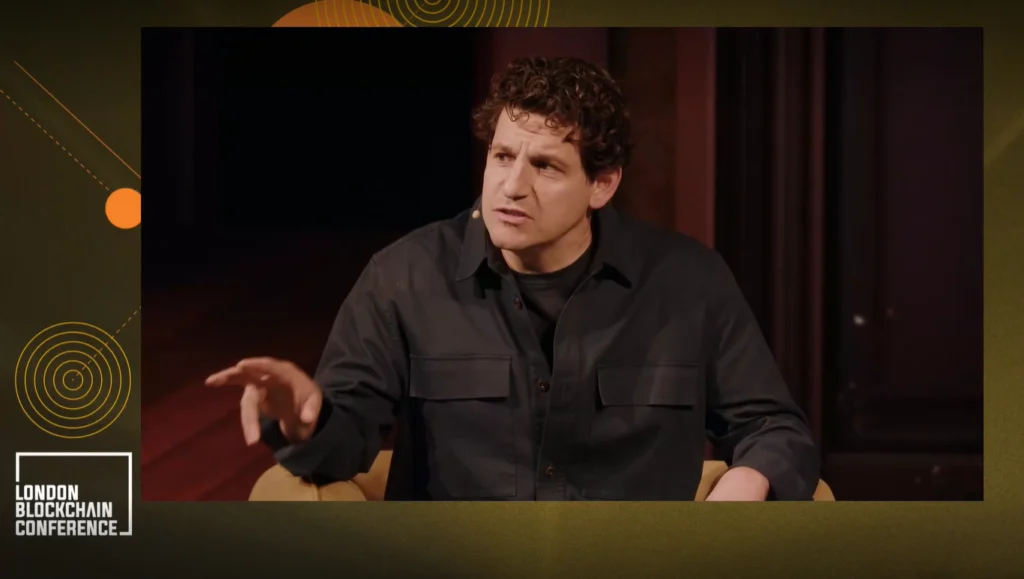Convincing governments to experiment with digitizing their data—and citizens to trust government to get it right—is a major challenge, but the rewards are well worth the struggle.
- Estonia blazes the digitization trail
- X-Road to digital success
- Fortune favors the bold
- Meaningful tokenization is the prize
The closing session of the London Blockchain Conference 2025 was a fireside chat in which BBC News reporter Mark Lobel sat down with Siim Sikkut, the Estonian founder of Digital Nation, one of the premier entities helping global governments digitize both their data and the services they offer their citizens.
As Lobel noted, there is probably no one better to query on the intersection of governments and technology than Sikkut, who served as Estonia’s chief information officer from 2017 to 2022, led the government’s digital policy area, and co-founded Estonia’s groundbreaking e-Residency program.
Named one of the top-20 most influential people in digital government, Sikkut remains on Estonia’s Presidential Digital Advisory Committee. In 2022, he released the book Digital Government Excellence: Lessons from Effective Digital Leaders, and now advises other governments on digitization through his role as Digital Nation’s managing partner.
Lobel kicked off the proceedings by asking Sikkut about the current appetite among global governments for digitizing data and services in a manner that is both efficient and secure.
Sikkut said, “everywhere in the world there’s a bit of crisis of delivery, getting things done.” But all is not lost, as “the funding agencies, the world banks and others in this game really have cracked that, hey, going digital means that you can boost development…economic growth, government productivity and so forth.” As more governments acknowledge this reality, “that raises appetite in the next ones.”
Lobel referenced the United Kingdom government’s current plan to issue digital identity cards, prompting Sikkut to quip: “About time.” Sikkut said there’s no way to “build up a full digital government without having some form of strong identity.” Estonia has had a similar system in place for over a decade, which Sikkut says proved a “cornerstone” in the government’s willingness to expand its digital efforts.

As the Asian economic crisis of the late-90s migrated to Europe, Sikkut said “productivity and efficiency were the driving forces. We had to slash government budgets fast…any ideas were welcome, so we started experimenting.”
“We had a lot of corporate examples of how you can be more productive in a corporate setting. From those experiments, we were able to gain efficiencies, government productivity, and so we made it into a conscious strategy. And it still goes on. I’ve been three years away from government now, but they keep at it, with strong adoption of artificial intelligence these days. Again, for the same productivity goals.”
Asked to gauge the success of Estonia’s digitization efforts, Sikkut said that, as both a citizen and entrepreneur, “everything I need to do with the government, there’s a digital option. Health, banking, starting a company, changing documents, simple things like changing your address, even. The whole thing has been, ‘let’s take the bureaucracy of getting things done with government, the red tape, and make that invisible.’”
“We also looked at the things that people want to do, like voting. More than half of people these days vote online for parliaments, local council, whatever. So it’s looking at every kind of interaction with government, how to offer digital means for that. It’s not just about backend efficiency. It saves time for people.”
For Sikkkut, “the only measure of success is do people actually use these things? You do digital transformation, provide digital services for an impact of use. Only then do you get the other outcomes like economic growth.”
The X-Road to digital success
Digital Nation offers a decentralized open-source product called X-Road that enables secure and efficient online data exchange both within government departments and between public and private sector information systems. X-Road is currently being used by over two dozen governments/jurisdictions around the world, including Ukraine, a nation with a population 30x the size of Estonia.
X-Road’s benefits are legion, as Sikkut notes from personal experience. “Governments set up architecturally a lot of data sets, but all connectable—if law allows for this, or you consent to this. Getting taxes done [in Estonia] is like three minutes. You can even do it automatically if you like. It’s pre-filled based on data pulled from distributed sources out there.”
However, there are serious security concerns involved in digitizing citizens’ personal data, not just from rogue actors dialing in from overseas, but also from the possibility of government agencies and their employees improperly accessing data stored by another government department.
As Lobel noted, that’s one of the primary benefits blockchain can offer, in that there is a verifiable record of who accesses your data, which acts as a significant deterrent for those with access to the system. As Lobel noted, a public servant who might want to dig deep into the personal details of a woman he’s dating might not be so motivated to snoop if he understood that the girl would have full awareness of his snooping.

Sikkut agreed, saying, “we publish the log about your data to you. So you get to see what’s happening to your data. I mean, you own it.” No system can guarantee perfect security, but in cases where a public servant has thrown caution to the wind and improperly accessed data, the evidence is irrefutable, and the consequences can be both swift and severe.
Fortune favors the bold
The benefits of governments going digital are immense, with Sikkut estimating that “even by just signing things digitally, we save in the whole of the [Estonian] economy at least 2% of GDP in terms of time.” Sikkut notes that this amount is higher than Estonia’s defense budget. But just like guns and drones, your data also needs defending.
“You wanna be digital, you gotta do proper cybersecurity and defense. You gotta build your whole frame of effort on this, all the way from how you design systems, what technologies you use, blockchain, for example, how you defend your systems, how you react to incidents, it’s the whole thing that has to be there.”
“It really comes down to how do we use the tech, what sort of risk are we opening ourselves into, and then how we manage the risk. We’ve got to be careful and conscious to try and build these defenses, even if it’s hard.”
The need for digital security has always been paramount. Sikkut referenced keyless signature infrastructure (KSI), a technology that predates blockchain. Sikkut and his partners began experimenting with early versions of KSI “because we had a need we couldn’t solve otherwise.”
Around the same time, some other researchers experimenting with distributed ledger technology (DLT) made a presentation to the Estonian government that basically said, “we have a technology that might work. We need somebody to try it on.’ There was no money exchange, there was no tendering. Government had a need, we joined forces. So there was open innovation.”
Sikkut said “the whole Estonian story has been experimentation. The early days we started making available tax declarations online to get more taxes coming in. X-Road was a master thesis that became a government experiment at first. Guarding for data integrity, keeping the metadata or the records about data in blockchain mode was an experiment at first. E-Residency was an experiment.”
Sikkut praised the Estonian government for being “willing to take the risk of trying things out. Often in governments, we want to have full certainty before we make any move. We debate endlessly, we want to have a perfect solution, and then nothing gets changed.”
Sikkut noted that Estonia’s e-Residency program was launched on a six-month trial basis, and there was a lot on the line. “Are we able to offer our digital identity for everyone in the world to set up a company in Estonia? How do we manage the risks of that, like money laundering? So six months, we had to prove it, and then we were able to scale from that.”
The ability to scale cannot be understated. “There are so many pilots happening in the blockchain space. How do you get from pilot to system-wide adoption? That’s where things like, boring word, governance mechanisms come in. Government is machinery. You have to build that machinery with proper mandates, proper institutional setup, collaboration, incentives, carrots, and sticks.”
Sikkut notes that the key to Estonia’s digital journey has been the government’s willingness to experiment. “All my political masters have really been careful to make a difference between failures. Is it because of ignorance or recklessness or something you did on purpose? Or is it because you legitimately tried stuff out and it didn’t work? The latter is not frowned upon.”
“One of my ministers, when I became a government CIO, made a distinct point to say, I want you to keep trying things out. Failure is okay. This is a lot of what leadership and risk-taking means in practice. We’ve been trying to be very public, in my work, not everything will be successful.”
Asked what lessons Sikkut learned from his time in government, he stated it plainly: “Do more and tell later. A lot of political rhetoric seems to be about we’re making these announcements and we’re gonna have this big thing.” A far better strategy is to show some restraint and “really push stuff out once it’s proven and tested.”
“Secondly, it’s way easier said than done, but keep steady. If you have feedback that something is working, if you can be sure you’re on the right track, at the end of the day, users start telling your story. If people get the benefit of what you’re doing, they’ll come behind you, and that can change the media wave.”
Meaningful tokenization
Asked where he expects the major breakthroughs to occur in terms of governments embracing digitization, Sikkut said he’d “put my money on the Middle East. I think now, the most ambitious strategy I’ve seen is in Abu Dhabi. They’ve pulled together a strategy saying ‘let’s make a test bed for these things,’ on tokenization, how to bring digital currencies into government, benefit payments, how to do proper smart contracting in government, AI agent registries in government, possibly. They said, ‘hey, we should be the place that tries that out.’”
Sikkut really wants to see “somebody do tokenization in government meaningfully.” Asked whether stablecoins will play a major role in tokenization efforts, Sikkut was ambivalent. “I would say it doesn’t matter. To me, the technology is like a secondary point. What’s the use case? What would really be useful in tokenizing some of the assets we keep in the registries in government and so forth?”
Sikkut sketched out a scenario in which “one government figures out something useful with [tokenization]. That’s what I’m eager about, because that can unleash the next [steps].” But Sikkut predicted that any government’s embrace of digitization has to start with digital ID, because everything else flows from that.
Finally, asked whether blockchain’s best business case was its ability to allow everyone—governments, corporations, and individuals—to keep experimenting, Sikkut offered the kind of open-minded, flexible position that got him where he is today. “Experimenting is not blockchain-specific. I would hope that the value would be unlocked through the experiment.”
Watch: Blockchain is much more than digital assets
title=”YouTube video player” frameborder=”0″ allow=”accelerometer; autoplay; clipboard-write; encrypted-media; gyroscope; picture-in-picture; web-share” referrerpolicy=”strict-origin-when-cross-origin” allowfullscreen=””>